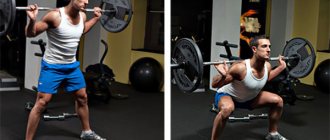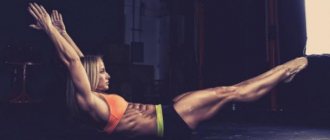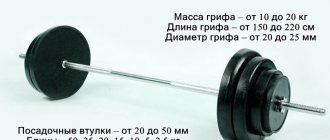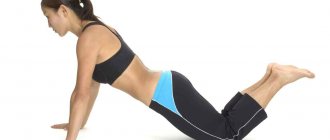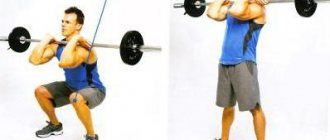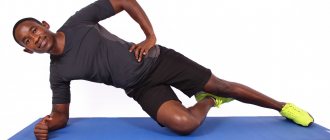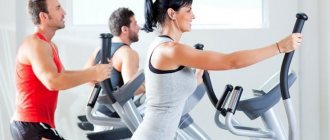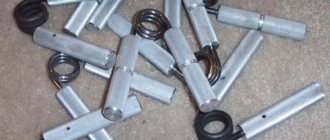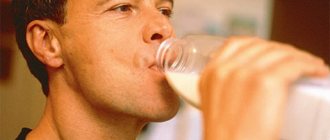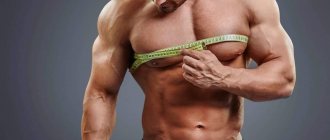Benefits and Disadvantages of Squats Without Weight for Men and Women
Benefits of air squats:
- Prepares muscles for deep squats with weights.
- Strengthens stabilizer muscles, which are responsible for maintaining the correct position of the joints.
- Give an understanding of the technique of performing squats with weights.
- The exercise can be included in all kinds of circuit training and CrossFit complexes aimed at increasing endurance and losing weight.
- Accelerates metabolism due to the speed of execution and the involvement of most muscles of the body.
- Does not injure joints and does not put pressure on intervertebral discs.
Disadvantages of the exercise:
- It does not allow you to increase muscle volume, since it does not involve working with weights necessary for these purposes.
- Jerking and not following safety precautions can injure joints and ligaments.
- Does not improve strength.
Squats for buttocks options types
In practice, there are countless options for squats. I don’t want to talk about everyone (why is this here), I will tell you only about those options that I consider telling you about:
- Squats with your own body weight in the “SUMO” style, without any additional equipment. weight; (ideal for beginners, as well as those who do not have any additional equipment at all).
- Sumo-style barbell squat;
- Sumo style dumbbell/kettlebell squat;
All squat variations are only in the “SUMO” style. Sumo style is when, when squatting, you have a WIDE FOOT STANDING (legs wide to the sides) + TURN YOUR TOES SLIGHTLY TO THE SIDE. Here, see photo below (sumo style):
No. 1. version with your own body weight:
No. 2. Option with a barbell on the shoulders:
No. 3. Option performed with dumbbells/kettlebells:
And it’s even better if you do this option only on some kind of height (platform, benches) (better because the range of motion increases, therefore, the exercise becomes much more effective than when you just stand on the floor), see below photo:
Do you see? This is just an example (here the weight on the belt weighs, but I recommend working simply with a kettlebell or dumbbells, holding it in your hands).
In general, the “SUMO” style emphasizes (so to speak more strongly) the MUSCLES OF THE INNER SURFACE OF THE THIGH + BUTTOCKS (buttocks), i.e. what we need (girls are interested in these particular muscle groups), and in addition, this style of squatting ALLOWS you to lift (squat) with a heavier weight than in other types of squats, accordingly, thanks to this the exercise becomes even more effective... Another important factor is that , that it is much easier to learn the sumo style (it is easy to perform compared to other types of squats), moreover)), the sumo style minimizes (relieves) the load on the quadriceps (i.e. the legs will not sway). In general, there are a lot of advantages from the SUMO style!!! I assure YOU, this particular type of squat is most effective for pumping up the gluteal muscles. That's why I recommend it.
What muscles work when squats without weight?
Basic:
- Quadriceps femoris muscles.
- Large gluteal muscles.
- Adductor muscles of the thigh.
- Soleus muscles.
Additional:
- Biceps femoris muscles.
- Calf muscles.
- Back extensors.
- Rectus abdominis muscle.
Answers@Mail.Ru: Is it possible to pump up your legs with squats 100 times a day?
Hooligan
Artificial Intelligence (1352444) 7 years ago
It is possible, but it will take a long time.
Marina D***
Guru (3073) 7 years ago
no, you'll only loosen your kneecap. and you need to strengthen your legs by lying down and lifting them one at a time and doing scissors with your legs and spinning the bike with your legs up.
Andrey
Pro (947) 7 years ago
I’m not sure exactly, but it’s unlikely, squats don’t strengthen the legs, but develop them, make them more mobile, and if they do, it’s more likely to strengthen the knees
fitnesspoint
Thinker (5964) 7 years ago Well, if you haven’t been pumping your legs before, it won’t be for long.
The muscle groups of the legs will quickly return to normal and growth will be established. You need to start with fewer repetitions. Don’t be afraid to pump up your legs so that they become huge like in the pictures of squats alone, oh how little))) And so you will have beautiful toned legs and everything else))) https://fitnesspoint.ru/info/?ID=4230 Joseph
the Thinker (5714) 7 years ago
One hundred squats is death for a beginner.
Deoxyribonuclease
Enlightened (20313) 7 years ago
no, if the goal is to pump up muscles, there is no better exercise than squats with a barbell; if you want to tighten your leg muscles, then lunges. And in any case, fitness is by no means every day; you need at least one day of rest between workouts
User deleted
Guru (2950) 7 years ago
It is possible, but only in 10 years... Like football players, they run all their lives (the main load), although running cannot pump up the (mass) of the legs in principle. Yes, and 100 times a day... You can easily ground the engine if you don’t start gradually.
silkin
Enlightened (23537) 7 years ago
No!!!! 11on the contrary, your legs will only dry out, it’s too much and monotonous... pump your legs 2 times a week, the first workout, squat with a barbell, do deadlifts, just not like in powerlifting with legs wide apart, so that your feet are shoulder-width apart... in the second workout, already on the machines download
Elizaveta Marakhova
Student (110) 2 years ago
Of course it is possible! I achieved results with this, and not in 10 years, but in 2 months! And no dumbbells are needed! At first I just did it 30 times, and then I increased it 40 times, 5 times each, and my legs became elastic and my buttocks too, and the muscles began to stand out! You just have to push yourself every day and everything will be OK!
Source: https://otvet.mail.ru/question/42594609
Air squat technique
- Place your heels hip-width apart, with your toes slightly pointed apart.
- In the starting position, all joints should be straightened and in the same plane.
- As you inhale, move your pelvis back, transferring your body weight to your heels, and perform a deep squat, in which the pelvis drops below knee level. At the same time, stabilize the spine with the muscles of the back and abdomen.
- When performing a squat, the arms rise from the bottom up, forming a continuation of the spine at the top point. This is necessary to further stabilize the back in a straight position. The hands are turned towards each other at the top, the arms are slightly bent at the elbows.
- As you exhale, push through your heels and straighten your torso while lowering your arms down.
- Repeat the movement.
Squats without weight: exercise technique[edit | edit code]
Squats are the ultimate lower body exercise. Moreover, the words “for the lower body” are not so important. It is almost impossible to develop functional strength without squats: doing them uses all the muscles of the legs, loads the abs and lower back.
Squats
Performing squats requires a lot of blood and oxygen flow to the legs - after all, they are one of the largest muscle groups in the human body. This means that the heart and lungs will also be involved in the work. Look at children - squatting is a natural movement for them, but most adults don’t mind lounging in chairs (and generally lead a lazy lifestyle) and completely forget this movement pattern. However, do not despair - as a rule, it can be restored quite quickly (but some will need to put in more time and effort).
There are many ways to learn how to squat. To perform squats technically, you need to know only three things: keep your heels off the floor, stick your butt out and keep your back straight. Keep this in mind when performing the exercise, and you will not have any special problems with technique.
Performing squats requires engaging both the knees and the hip joint. However, at the initial stage you should control yourself: the movement begins from the pelvis, the knees are involved next. If squatting is new to you, it may take some time to understand the mechanics of the movement. It was mentioned earlier about the need to keep your back straight, but this does not mean that you cannot lean forward: otherwise you will simply fall. You just need to arch your lower back, not your back.
As the hips move back, the body must lean forward to maintain balance. Bend your ankles slightly, keeping your heels on the floor, and push your knees forward. To maintain balance, you can stretch your arms in front of you.
While at the bottom, you need to make sure that your head and heels are still in the same line. Of course, given that your hips have moved back. and knees forward. At the bottom, your head, shoulders and heels should be in line.
Just like push-ups, squats require you to spend a lot more energy maintaining your posture. When moving your hips back, you will need to tighten your lower back and abs to maintain correct posture in the lumbar region, as well as the muscles of the upper back to maintain this in the thoracic region. In addition, tight chest muscles will prevent you from slouching. Imagine that you have to push your shoulder blades down and back to maintain the pose.
Deep squats[edit | edit code]
Many trainers still believe that deep squats are dangerous for the knee joints. Ideally, while maintaining a natural posture, anyone should be able to squat so deeply that the hamstrings and calves touch at the bottom. Unfortunately, in America almost no one can perform even half the amplitude of the exercise without losing their posture. Here the question of how deep you should squat is as follows: “how deep you can squat.”
This means that for many people it will be impossible to squat below the level where the thigh is parallel to the ground, which is only half the amplitude of a full exercise. But if they cannot sit lower, then this is enough. For them, the bottom of the squat should correspond to a position in which their thighs are parallel to the ground.
Back under attack[edit | edit code]
Even though unweighted squats have more back mobility than barbell squats, you can still get the most out of each rep if you pay attention to your posture. The human back is mobile and flexible. however, the habit of always and everywhere maintaining correct posture will come in handy in strength training.
Foot placement[edit | edit code]
With the standard squat technique, the legs are shoulder-width apart. However, by varying the distance between your legs, you can load different muscle groups differently. Some people may find it more comfortable to squat with a wider stance; this position allows them to sink deeper without losing their posture. If this applies to you, then you can safely start practicing wide-legged squats. You can make the exercise a little easier and increase the range of motion by slightly turning your feet outward. Performing standing squats with legs close together and feet parallel will be a more complex form of exercise.
Bench squats[edit | edit code]
If you feel like you might fall while doing squats, you can use a bench or something like that to maintain your balance. Something stable and low is best for this. At the initial stage, it will be enough for your thighs to be parallel to the ground, in contact with the bench. To perform this variation of squats, simply stand in front of a bench and sit on it. If you lose your balance in the process, simply plop down on the bench and then stand up and try again. Over time, you will gain better control of your body during the squat. Then you can start squatting onto lower objects. Over time, you will be able to squat without support until your buttocks touch your ankles.
However, you should not give up doing squats on a bench even after mastering the usual ones. The presence of support at the bottom of a squat can not only make the exercise easier, but also complicate it: strength and the ability to maintain balance are no less important in order to lift the body from a sitting position.
Sumo squats[edit | edit code]
This variation of the exercise is named after the wrestling style. The sumo squat is “an exaggerated version of the wide-legged squat, where the feet are turned out almost to the limit, which puts additional stress on the muscles of the lower thighs. As with the plie stance, this type of squat may be easier for beginners to perform: if you have difficulty maintaining balance and/or posture during the exercise, then sumo squats may be just the thing. But don't underestimate this exercise: it can be useful for anyone who wants to strengthen the muscles of the inner thigh. Keeping your feet aligned is essential when performing any type of squat, but in this case, special care should be taken to ensure that your knees point in the same direction as your toes rather than curling forward.
Squats with lunge[edit | edit code]
Another great variation of squats. In this case, when performing the exercise, the center of gravity shifts, and the load on the muscles appears at a different angle. To perform squats with a lunge, you need to stand in a “scissors” pose, in which one leg is brought forward and the other is retracted back (compare with regular squats, for which you need to put your legs close to each other, and even so that they are under the hips ). In this case, the foot of the front leg should rest on the ground, but the foot of the back should be perpendicular to it (rest under the toes). Regarding the position of your arms when performing this type of squat, you can simply relax them and let them hang at your sides, but some people like to rest them on their sides. Both options are acceptable.
Now start squatting until both your knees form an acute angle, but do not forget about your posture. Return to the starting position. Try moving this way. so that the knee of the back leg bends first. Otherwise, you may end up dropping too much on your front knee without putting enough weight on your back knee. Try to maintain your center of balance at a point halfway from one foot to the other.
Walking lunges[edit | edit code]
Walking lunges require you to take a step forward with each repetition (unlike lunge squats, in which you return to a scissors position). But even here you need to keep your back and make sure that the foot of your front leg remains on the ground. To understand the correct technique, you can “break” the exercise into three stages: moving forward, then down, and finally, smoothly returning to the starting position. This will help you maintain your posture when squatting.
Reverse walking lunges[edit | edit code]
Another common type of squats. To perform it, you need to straighten up, and then take a step back and take a scissor pose.” Unlike regular lunges, this type of exercise puts less stress on the joints: people usually perform a forward step with more energy than a backward step. In addition, it does not require much space to complete it. Now return to the starting position from which you can begin the next repetition. As with all other types of lunges, there are two equivalent ways to perform them: you can change legs after performing a certain number of repetitions of each, or you can do it every other time.
“Prison” squats[edit | edit code]
When learning the squat technique, you should stretch your arms in front of you to maintain balance. However, having learned this, you can begin to perform the exercise with your hands behind your head: changing the center of gravity will help increase the intensity. In addition, with a similar technique, you can stretch the muscles of the upper back well: while doing squats, move your shoulder blades back and maintain your posture, do not slouch.
Wall squat[edit | edit code]
This exercise also has another name - “Chinese chair”. Be prepared to test not only your physical, but also your strong-willed qualities. Lean against the wall and squat so that your thighs are parallel to the ground. Stay in this position, but do not rest your hands on your legs: lower them to your sides or cross them over your chest. Imagine sitting on a chair without a seat.
Like the plank, the wall squat is an isometric exercise, so try to hold it for as long as possible. Take a deep breath and clear your mind. Even a beginner should try to hold himself in this position for about 30 seconds. Over time you will be able to get up to a few minutes. As with the plank, the duration of this exercise depends on your determination.
Author: Al Kavadlo
Common mistakes in squats without weights
- The body weight is transferred to the socks. Despite the fact that the spine is not pressed down by additional weights, a shift in the center of gravity increases the load on the knee joints. In this case, the heels may come off the floor, which also creates additional stress on the ankle joints.
- Rounding the back. The apparent safety of squats without a load does not allow performing the exercise with an incorrect back position. Rounding the spine relaxes the stabilizer muscles, which should receive additional load and protect the vertebrae.
- Bringing the knees together. Shifting your knees to the center not only increases the risk of injury and exposes the knee joints to additional stress, but also reduces the effect of the exercise on the gluteal and adductor muscles. If you control the position of your knees, which should be turned towards your toes, your hips and buttocks will develop correctly without the risk of injury.
Advantages
In addition to the obvious benefits of exercise for the muscles of the lower body, squats help develop the knee and hip joints, develop balance, and identify problems of disproportionate development of the right and left half of the body.
Performing air squats - back straight, arms extended forward for balance.
Regularly performing squats without weight gives the following results:
- The muscles of the legs and buttocks become toned: quadriceps, hamstrings, gluteus maximus.
- The articular-ligamentous apparatus is strengthened and flexibility improves. This, in turn, serves to prevent injury when performing more difficult types of squats.
- The cardiovascular system is trained. As a rule, the exercise is performed at a pace slightly above average. As a result, endurance increases.
- Coordination of movements and balance improves. In the first stage, you can use your hands to increase stability. Then it will be unnecessary.
- You practice basic movement techniques, such as proper knee and lower back position, with minimal risk to yourself. When performing weight-bearing exercises, errors in technique can result in serious injury.
An undoubted advantage is also that you can perform the exercise anywhere and anytime - both in the gym and at home. The main thing is not to forget about the importance of warming up.
Before squats, you should stretch the muscles of your legs, arms and hip joint. Many athletes like to squat after running or using the elliptical machine. After cardio, the muscles are quite warmed up and respond well to the load.
FAQ
How many calories do squats burn without weight?
In five minutes of continuous squats without weights, you can burn about 43-50 kcal. This is an individual indicator that depends on the person’s initial data - weight, physical fitness, metabolic rate, as well as speed of execution, and the like.
About an hour of doing squats will burn between 200 and 400 kcal. Of course, you shouldn't limit yourself to just one exercise. To increase its effectiveness and the number of calories lost, it is necessary to combine squats with other cardio and strength exercises.
Do Air Squats Grow Muscles?
The inability to increase muscle size is one of the disadvantages of this exercise, since growth requires large working weights, which cause microdamage to muscle fibers, which subsequently recover and grow. The lack of weight explains the impossibility of this process.
Is it possible to tighten your butt with squats without weights?
As explained in the previous paragraph about the impossibility of muscle hypertrophy without weight, the growth of any muscle, be it gluteal or quadriceps, is impossible without the presence of a certain load, which is performed with heavy weight for a maximum of 10-12 repetitions.
Do squats without weight make your legs swing?
The leg muscles still receive a load, but this is still not enough for muscle growth, but quite enough for strengthening and increasing tone, especially in the initial stages of training. Therefore, if by this question you mean obtaining relief and increasing muscle density, then squats without load are a suitable option for this.
About the different types of squats
No one doubts the benefits of squats without weight for men and women. The exercise is necessary to give a beautiful shape to a person’s buttocks and legs, and the type of squats determines which parts of the legs are loaded more and which are used less.
First of all, the starting position largely determines the load on the muscles. The wider your legs are from each other during squats, the more load the inner thighs receive, and the less load falls on the buttocks. The depth of the squat also plays a fundamental role; the lower the athlete sits, the more the buttocks are involved in the work.
Squats are a compound exercise. This means that in the process of performing them, various muscle groups are involved in the work, and not just the muscles of the buttocks and thighs; in fact, the entire lower part of the person’s body receives physical activity.
Can't build up your legs without squats?
With the incredible benefits of modern science, technology and modern medicine, you have an exceptional opportunity to access information that will help you build a phenomenal physique. But the search itself for the necessary information regarding diet, training and sports nutrition and their correct combination is akin to a fine art or, if you like, putting together a complex puzzle.
Just like the ongoing discoveries in the medical field, the optimal paths for achieving muscle growth and success as an athlete are constantly changing. Rules and guidelines, once accepted as dogmas, undergo changes and improvements almost every day. Let's look at one of the most common questions that newbies ask.
The only way to pump up your legs is to squat
This is actually a trick question. If you look at most athletes who have superbly developed leg muscles, their training process is built around hardcore squats. However, their success comes from more than just heavy squats.
This development of the legs was achieved thanks to the intensity of training to the limit of physical capabilities, and squats are only the main tool. The great thing about squats as an exercise is the fact that it itself forces your body to exert incredible effort.
In the case of exercise machines, it is simply impossible to develop such intensity.
The truth is, you can build great legs using hack squats, Smith machines, or leg presses.
However, the vast majority of people cannot develop the same animalistic, hardcore drive when using machines compared to traditional squats.
Intensity and overcoming mental barriers are key to any workout, but when it comes to leg training, it's especially important.
Pay attention!
Will squats help you build monstrous legs? Still would! But you will have to overcome that line that you usually reach when working on exercise machines, when you think it’s time to stop.
It's much easier to stop doing a machine exercise when you feel a burning sensation in your muscles than when you've walked a few steps away from the racks with hundreds of kilograms on your back. You can achieve the same thing with machines - all you need to do is push yourself beyond the point of failure, just like with squats.
Many athletes are incredibly strong at squats. Their working weights exceed the mark of 320-360 kg. But at the same time, they do not have monstrously developed leg muscles. They are simply strong.
You may be strong at a particular movement, but if your body adapts to a particular exercise or load, growth may slow or stop altogether. This is the case when you can turn to the help of simulators.
Work the muscles from different angles and see which of all this variety can stimulate the muscles and spur their growth process.
When creating an individual leg training program, you need to think carefully about everything and remember that this is a huge muscle group that is constantly used in everyday life.
Therefore, legs need to be trained harder than any other muscle group.
Undoubtedly, genetics plays a big role, but mental attitude and ultra-intensive training can more than compensate for this factor.
Source: https://power-body.ru/bez-prisedaniy-ne-nakachat-nogi/
Do squats help?
Find out whether squats help, whether it is useful to do it, and whether you can pump up your buttocks with the help of squats. Here you can read the advice of trainers and learn all the subtleties.
Answer:
Beautiful legs are a source of pride for women. But not every woman is happy with her legs. How to put them in order if they are far from ideal, so that short skirts and dresses are a joy?
First, you need to reconsider your diet, remove everything harmful, and give up sweets and fried foods as much as possible. You should not resort to diets, since the body is under enormous stress at this time, and after finishing the diet it will try to regain lost reserves. The ideal option would be proper nutrition.
Pay attention!
There are many exercises for losing weight in the legs. Squats are considered one of the most popular. In order for your legs to lose weight, you need to squat at least 100 times a day. You cannot do all the exercises at once; this is very harmful to the joints. It is better to divide the amount into several approaches throughout the day. Gradually, the load can be increased by doing more sets or squats with weight.
For those who doubt whether squats help, you can check the effect from your own experience. You will see that the “ears” on your hips will go away, your buttocks and abdominal muscles will tighten. Exercise is beneficial for building muscle mass throughout the body, burning calories and helping to lose belly fat. But, besides squats, it is necessary to perform other exercises to lose weight in your legs.
Is it useful to do squats?
Any athlete, when asked, “is it useful to do squats?” will say with confidence that yes. Their benefits are hard to overestimate. Squats are part of every athlete’s training program; without them, it’s hard to imagine a physical education class or fitness class.
When squats, the muscles of the buttocks and thighs work. Additional stress is placed on the spine, tendons under the knees, lower back muscles, and partly on the abs. Exercise helps not only build muscle mass and lose weight, but also prevent many diseases.
But there will be absolutely no benefit from squats if you do them incorrectly. In order not to waste your time and energy, you need to know how to squat correctly. You need to squat with a straight back, leaning forward slightly.
This should be done without sudden jerks, smoothly and slowly. It is absolutely forbidden to squat too many times. It is better to do several approaches of a small number of squats. During the exercise, the foot should not leave the floor.
Once the squats begin to feel easy, you can increase the load by squatting with weight.
Squats are contraindicated for people who have had leg or spinal injuries. It is better to replace them with other, easier exercises.
Is it possible to pump up your buttocks with squats?
To pump up your gluteal muscles, you don’t even have to go to the gym. For a toned butt, it is enough to squat correctly. You can do the exercises at home, and the results will not be long in coming.
Everyone wants a toned butt, but many do squats to get it wrong. For example, when the legs are shoulder-width apart during the exercise, the gluteal muscles practically do not work, and the load falls on the quadriceps, and only the legs swing.
To squat correctly, you need to spread your legs wide, straighten your shoulders, and stretch your arms forward.
It is important!
During the squat, your knees should remain over your heels and your pelvis should be pushed back, while your body leans forward approximately 45 degrees.
If the body bends too much, the back muscles will work and sway. Squats should be done as deeply as possible. This will transfer the load from the legs and back to the gluteal muscles.
To enhance the effect of squats, you need to squat with weight. It needs to be selected individually, it depends on personal weight and physical fitness. To begin with, a dumbbell weighing 2 kg will be enough. Gradually it can be increased to 50 kg. For those who have decided to check whether it is possible to pump up their buttocks with squats, but have not played sports before, it is better to start under the guidance of a trainer.
Source: https://www.all-answers.ru/index/sport/pomogajut-li-prisedanija
The benefits of squats without weights
The very first thing that awaits any beginner in a proper weight room is learning how to squat without weights. To begin with, the trainer will ask you to sit down as comfortably as possible. And you will repeat what you repeat day after day - place your feet at a comfortable width and abduct your pelvis. You won't even think about two key points that are important for proper squatting:
- the body should be stable, the shoulder blades should be tight, the arch in the lower back should be natural, and the stomach should not rest on the hips;
- squatting is flexion and extension at the hip and knee joints. Emphasis on only one articular group is unacceptable.
Most beginners will squat without thinking about the position of their back and stomach, and will try to gain depth through extreme knee bending.
How to learn to squat with the correct body position? There are several options:
- classic squat with wide foot placement “chest against the wall”. At the same time, the arms are raised upward, palms on the wall. The goal is to lower your pelvis as low as possible. The wall will not allow the position of the body to be distorted;
- classic squat with a gymnastic stick. The stick is held with the hands above the head, the technique is the same;
- squatting with wide feet on a low box, with a gymnastic stick in your hands (over your head). There is no need to “sit” on the box, as strength athletes do when training power. You just have to touch it lightly and get up again.
The main mistake in squats “of all times and peoples” is an attempt to solve some particular problems without mastering the technique of the basic exercise. Let's say a girl wants to pump up her buttocks and lose excess weight. Somewhere on a social network she reads that 100, or better yet, 200 squats a day will help her solve this problem. And he begins to squat, increasing his “habits” of incorrect movement. Why so categorical? Yes, because an untrained person will not do 100 squats in pure technique without a break, unless, of course, he miraculously runs a 15-20 km distance and again miraculously never squats.
You need to go gradually to develop form and technique. And while you are gradually walking, for the same pumping up of the buttocks, it is advisable to use isolating exercises in machines or with weights (swings, flexions, abductions). But the emphasis in training should be shifted towards squats. At the beginning of the lesson, we teach the technique, and only then we “wave” 3 x 15 or 4 x 20, or whatever is prescribed to you by the trainer.
Again, there is no need to panic that you won’t be able to lose weight with squats. At this level of physical fitness, the problem will still have to be solved primarily through diet. Therefore, you shouldn’t invest too much in trying to burn calories by squatting.
Classic barbell squats
Hello friends! This time we will look at one of the best basic exercises - squats. It is done by beginners and professionals, men and women, and is even used for rehabilitation purposes. What’s so good about it and how to make it, we’ll figure it out.
Squats can be done with a barbell (this is a classic and this is the option I will use), with dumbbells, on a machine, without weights at all. This exercise is rightfully considered one of the main exercises in bodybuilding and powerlifting, along with exercises such as the deadlift and bench press.
Why are squats so good? It's simple - this exercise involves many muscle groups . Yes, the main load goes to the thigh muscles, but the gluteal muscles, all the muscles of the lower back and even the abs take part in it. You need to control your entire body when doing squats.
It is important!
Squats cannot be completely replaced by any one exercise, and if you replace them with several, the effect will still not be the same. The fact is that the more muscle groups involved in performing an exercise, the more stress the body experiences. And, as a result, the more growth hormone it releases.
That's why you've often heard phrases about base, squat and mass in the same sentence.
Squats ideally develop the quadriceps and all 4 muscles are included in the work. Squats also train the gluteal muscles and are considered the best exercise for getting a round, toned butt.
CLASSIC OPTION
This can be done using either a power rack or a Smith machine. In the first option, it is advisable to have a person nearby who can provide backup. At first, it’s still better to do squats without a machine. This is explained by the fact that, without having fixed axes (as in a simulator), a person works with free weight .
Free weights are the best option for performing exercises, because in this option, stabilizer muscles are included in the work, and the overall load on the body is greater . More intense load = faster results.
The Smith machine can be used in cases where you are using really heavy weights and do not have two people for backup.
We approach the power rack and place the barbell on our shoulders so that it rests on the trapezius and deltoids. The grip width should not be wide, but sufficient to comfortably hold the weight. Moreover, when you have bulky arms, it is physically impossible to hold the barbell with a narrow grip.
The width of your feet is at their most stable position, slightly wider than your shoulders. The most stable position is easy to rehearse. To do this, you need to imagine that you want to jump forward from a standing position. Get ready to jump (no need to jump) and your legs will choose the most reliable stance.
The back is arched , it is impossible to round under any circumstances. If you round your back, you will get a spinal injury.
The head is in a position where your direct gaze is directed forward and slightly upward. This position of the neck allows you to control the correct arch of the back.
Helpful advice!
When performing the exercise, the knees should not go forward beyond the level of the toes, otherwise traumatic stress . In order to complete this task, move your pelvis back, as if there is a chair behind you that you are about to sit on.
Interesting: How to pump up an elastic butt
When lowering, in order not to lose balance, the upper body (chest and shoulders) automatically lean forward. Someone tries to perform it as straight as possible, but I am sure there is nothing wrong with such a tilt, since the movement is natural for our body.
The toes of our feet should be directed identically to the knee joints.
We work within the amplitude - at the top point of the movement we do not fully straighten our legs at the knees and do not straighten our lower back. This guarantees constant tension in the quadriceps and, as a result, improved control of movements.
We do it smoothly, up – exhale, down – inhale.
We push the body with our heels , not with our toes! You should feel all the weight on your heels, and your toes should be in a position where you can pass a piece of paper under them. That is, practically without touching the floor (if the weight is on the heels, this will be the natural position of the socks, do not be surprised).
How deep to go? There is an opinion that if, when performing squats, the bend angle in the knees is less than 90 degrees , then this will greatly load the knee joints.
But squats are a natural movement for our legs, so don’t be shy about squatting below a right angle - nothing bad will happen, everyone squats like that.
A smaller angle means a larger amplitude, which results in a greater load on the quadriceps.
* The narrower the legs are, the more load the outer thigh receives; the wider are, the greater the load on the inner thigh and gluteal muscles.
* If you have poor stretching and want to raise your heels when doing squats, place something under them, such as pancakes or a board.
ERRORS
The most common mistakes when squatting, which should not be made, because it will all end in failure, you will get serious injuries to your knees and back.
1. Round back
2. Head looks down
3. Weight on toes
4. Knees extend beyond your toes.
Control these moments and everything will be fine.
Pay attention!
On this wonderful note, regarding the standard version of squats, which is suitable for everyone and is mandatory in any program, I propose to end this discussion. Let's look further at the different variations of this exercise.
Phil
Source: https://feel1force.ru/yprajneniya/klassicheskie-prisedaniya-so-shtangoy/
